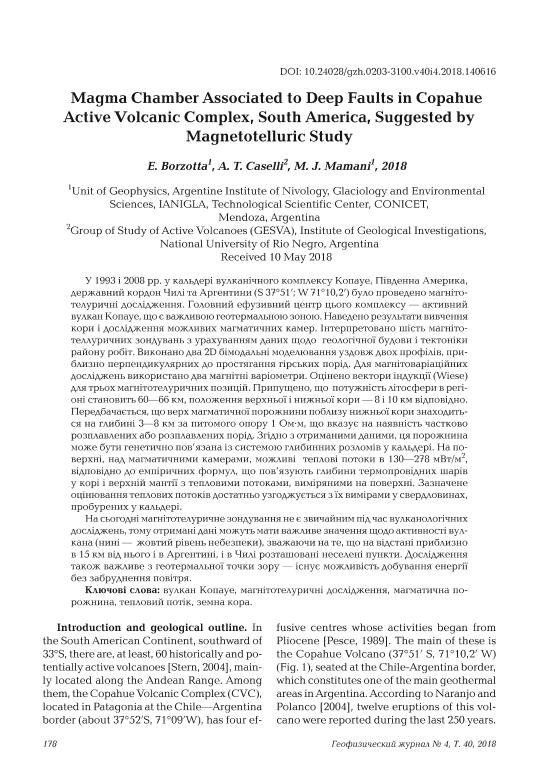Mostrar el registro sencillo del ítem
dc.contributor.author
Borzotta, Enrique

dc.contributor.author
Caselli, Alberto Tomás

dc.contributor.author
Mamani, Manuel Jesus

dc.date.available
2019-11-20T21:57:45Z
dc.date.issued
2018-08
dc.identifier.citation
Borzotta, Enrique; Caselli, Alberto Tomás; Mamani, Manuel Jesus; Magma Chamber Associated to Deep Faults in Copahue Active Volcanic Complex, South America, Suggested by Magnetotelluric Study; National Academy of Sciences of Ukraine. Subbotin Institute of Geophysics; Geofizicheskiy Zhurnal; 40; 4; 8-2018; 178-190
dc.identifier.issn
0203-3100
dc.identifier.uri
http://hdl.handle.net/11336/89330
dc.description.abstract
Magnetotelluric studies were carried out in 1993 and 2008 inside the caldera of Copahue Volcanic Complex, located in South America, at the border between Chile and Argentina (37°45ʹ S; 71°10.2ʹ W). The main effusive centre of this complex is the Copahue Active Volcano, which constitutes an important geothermal zone. The study of the crust and the investigation of possible magma chambers were the objectives of this survey. Six magnetotelluric soundings were interpreted taking in mind the geologic and tectonic background. Two 2D bimodal modelling along two profiles approximately perpendicular to geological strike were performed. In addition, two magnetovariational studies were made, using two magnetic variometers. Induction (Wiese) vectors were thus estimated for three MT sites. Among the results, the lithosphere in the region is suggested to be 60—66 km thickness, with upper and lower crusts of 8 km and 10 km thickness respectively. A magma chamber is suggested at lower crust with top at 3—8 km depth, with 1 Ωm of resistivity, thus indicating partial-melting or melted-rocks. Data suggest this chamber could be genetically associated with a deep fault system into the caldera. Heat flows of 130—278 mW/m2 were estimated at surface, above magma chambers, using empirical formulas linking depths of thermal conductive layers, in the crust and upper mantle, with heat flows values measured at surface. The estimated heat flows, thus obtained, are rather consistent with heat flows measured in wells drilled into the caldera. Taking into account that magnetotelluric soundings, at present, are not usual in volcanic studies, the present work may give valuable information about this active volcano, (which at present is in yellow alert), mainly because there are people living at about 15 km from the volcano or less in Argentina and Chile. In addition this study is important from geothermal point of view, for the possibility to obtain energy without air contamination.
dc.format
application/pdf
dc.language.iso
eng
dc.publisher
National Academy of Sciences of Ukraine. Subbotin Institute of Geophysics
dc.rights
info:eu-repo/semantics/openAccess
dc.rights.uri
https://creativecommons.org/licenses/by/2.5/ar/
dc.subject
Magnetoteluric
dc.subject
Chambers Magma
dc.subject
Copahue Volcano
dc.subject
Deep Structure
dc.subject.classification
Vulcanología

dc.subject.classification
Ciencias de la Tierra y relacionadas con el Medio Ambiente

dc.subject.classification
CIENCIAS NATURALES Y EXACTAS

dc.title
Magma Chamber Associated to Deep Faults in Copahue Active Volcanic Complex, South America, Suggested by Magnetotelluric Study
dc.type
info:eu-repo/semantics/article
dc.type
info:ar-repo/semantics/artículo
dc.type
info:eu-repo/semantics/publishedVersion
dc.date.updated
2019-08-08T19:08:57Z
dc.identifier.eissn
2524-1052
dc.journal.volume
40
dc.journal.number
4
dc.journal.pagination
178-190
dc.journal.pais
Ucrania

dc.journal.ciudad
Kiev
dc.description.fil
Fil: Borzotta, Enrique. Consejo Nacional de Investigaciones Científicas y Técnicas. Centro Científico Tecnológico Conicet - Mendoza. Instituto Argentino de Nivología, Glaciología y Ciencias Ambientales. Provincia de Mendoza. Instituto Argentino de Nivología, Glaciología y Ciencias Ambientales. Universidad Nacional de Cuyo. Instituto Argentino de Nivología, Glaciología y Ciencias Ambientales; Argentina
dc.description.fil
Fil: Caselli, Alberto Tomás. Consejo Nacional de Investigaciones Científicas y Técnicas. Centro Científico Tecnológico Conicet - Patagonia Norte. Instituto de Investigación en Paleobiología y Geología; Argentina
dc.description.fil
Fil: Mamani, Manuel Jesus. Consejo Nacional de Investigaciones Científicas y Técnicas. Centro Científico Tecnológico Conicet - Mendoza. Instituto Argentino de Nivología, Glaciología y Ciencias Ambientales. Provincia de Mendoza. Instituto Argentino de Nivología, Glaciología y Ciencias Ambientales. Universidad Nacional de Cuyo. Instituto Argentino de Nivología, Glaciología y Ciencias Ambientales; Argentina
dc.journal.title
Geofizicheskiy Zhurnal
dc.relation.alternativeid
info:eu-repo/semantics/altIdentifier/doi/http://dx.doi.org/10.24028/gzh.0203-3100.v40i4.2018.140616
dc.relation.alternativeid
info:eu-repo/semantics/altIdentifier/url/http://journals.uran.ua/geofizicheskiy/article/view/140616
Archivos asociados
